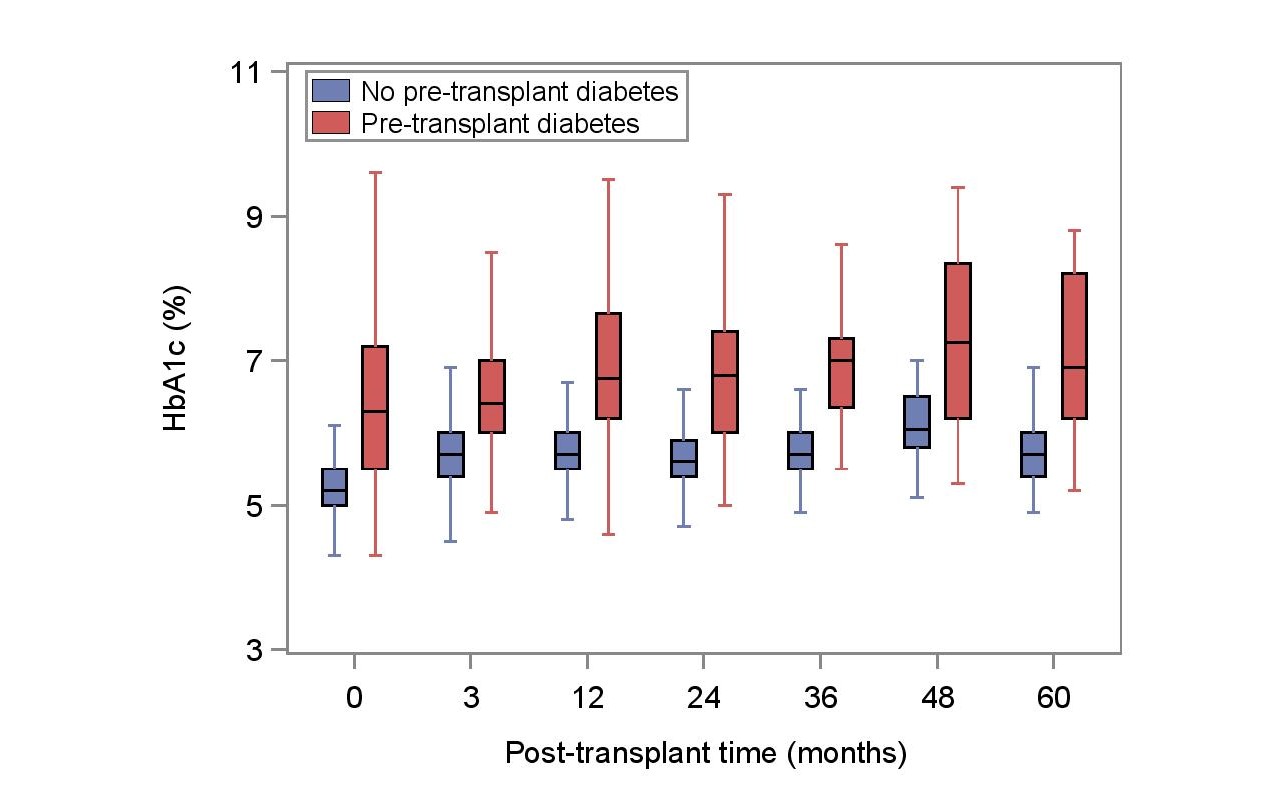Prevention of Diabetic Nephropathy after Kidney Transplantation Requires More Than Pursuing Low Levels of Glycated Hemoglobin
M. Coemans, E. Van Loon, E. Lerut, D. Kuypers, B. Sprangers, P. Gillard, C. Mathieu, G. Verbeke, M. Naesens
KU Leuven, Leuven, Belgium
Meeting: 2019 American Transplant Congress
Abstract number: C178
Keywords: Histology, Kidney transplantation, Multivariate analysis, Nephropathy
Session Information
Session Name: Poster Session C: Kidney: Cardiovascular and Metabolic
Session Type: Poster Session
Date: Monday, June 3, 2019
Session Time: 6:00pm-7:00pm
 Presentation Time: 6:00pm-7:00pm
Presentation Time: 6:00pm-7:00pm
Location: Hall C & D
*Purpose: Diabetic nephropathy is the leading cause of end-stage renal disease and progresses in five stages. During the second stage, morphologic lesions develop, without signs of clinical disease. The impact of diabetes on the evolution of this renal histology and the role of glycemic control (HbA1c) herein, remains insufficiently understood.
*Methods: We performed a cohort study based on a prospectively collected database at a single kidney transplant center. In total, 953 single kidney transplantations performed between 2004 and 2013 were included, with histological data on 3458 protocol biopsies, obtained up to 5 years after transplantation. We studied the effect of post-transplant HbA1c (median of 6 measurements per patient, in total 8750 measurements) on the occurrence of chronic lesions in kidney allografts using a joint longitudinal-survival model.
*Results: Pretransplant diabetes was present in 164 of 953 (17.2%) renal allograft recipients, primarily type 2 (N=146; 89.0%). Naturally, these patients showed higher levels of HbA1c post-transplantation (see Figure). A linear mixed model for the individual HbA1c trajectories and an interval-censored, proportional hazards survival model were fitted simultaneously in order to test for a cumulative HbA1c effect on the hazard of first occurrence of certain histological lesions. Although HbA1c levels at the time of transplantation were significantly associated (P=0.03) with the occurrence of mesangial matrix expansion in the kidney allograft (HR 1.23; 95% CI, 1.02 to 1.48), no cumulative HbA1c effect was present (HR 1.03; 95% CI, 0.90 to 1.18; P=0.61).
*Conclusions: We concluded that pre-transplant diabetes patients, on average, showed higher values of HbA1c after transplantation. However, our joint model illustrates that the susceptibility to diabetic nephropathy lesions was not associated with the individual, cumulative HbA1c trajectories. Prevention of diabetic nephropathy recurrence after transplantation thus requires more than pursuing low levels of glycated hemoglobin. The effects of novel antidiabetic agents on post-transplant recurrence of diabetic nephropathy need further evaluation.
To cite this abstract in AMA style:
Coemans M, Loon EVan, Lerut E, Kuypers D, Sprangers B, Gillard P, Mathieu C, Verbeke G, Naesens M. Prevention of Diabetic Nephropathy after Kidney Transplantation Requires More Than Pursuing Low Levels of Glycated Hemoglobin [abstract]. Am J Transplant. 2019; 19 (suppl 3). https://atcmeetingabstracts.com/abstract/prevention-of-diabetic-nephropathy-after-kidney-transplantation-requires-more-than-pursuing-low-levels-of-glycated-hemoglobin/. Accessed December 16, 2025.« Back to 2019 American Transplant Congress

